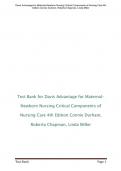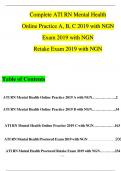Exam (elaborations)
Test Bank for Davis Advantage for Maternal-Newborn Nursing Critical Components of Nursing Care 4th Edition Connie Durham, Roberta Chapman, Linda Miller
- Course
- Institution
Davis Advantage for Maternal-Newborn Nursing Critical Components of Nursing Care 4th Edition Connie Durham, Roberta Chapman, Linda Miller
[Show more]












